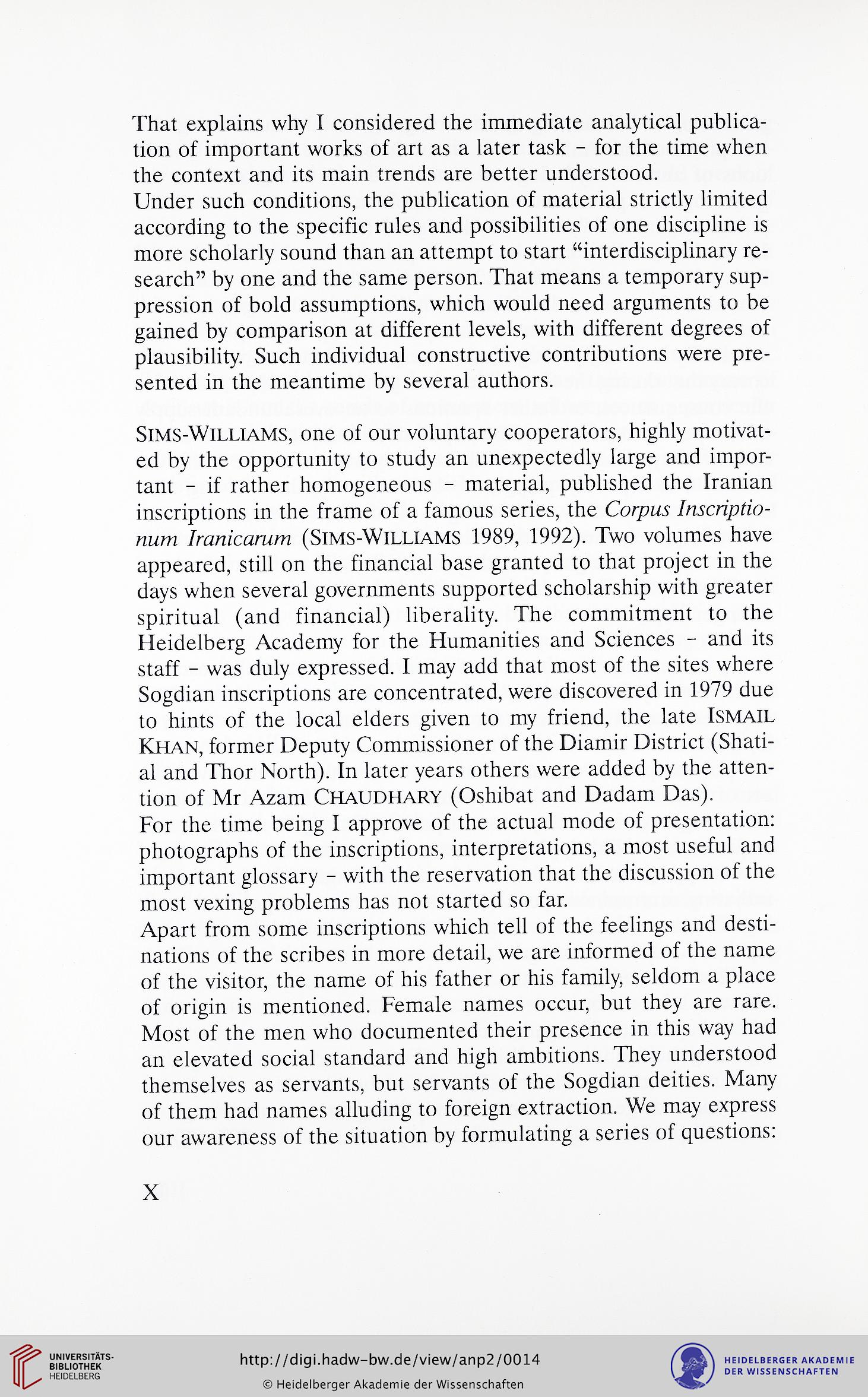That explains why I considered the immediate analytical publica-
tion of important works of art as a later task - for the time when
the context and its main trends are better understood.
Under such conditions, the publication of material strictly limited
according to the specific rules and possibilities of one discipline is
more scholarly sound than an attempt to start "interdisciplinary re-
search" by one and the same person. That means a temporary sup-
pression of bold assumptions, which would need arguments to be
gained by comparison at different levels, with different degrees of
plausibility. Such individual constructive contributions were pre-
sented in the meantime by several authors.
SlMS-WlLLlAMS, one of our voluntary cooperators, highly motivat-
ed by the opportunity to study an unexpectedly large and impor-
tant - if rather homogeneous - material, published the Iranian
inscriptions in the frame of a famous series, the
nnm /ramcamm (SlMS-WlLLlAMS 1989, 1992). Two volumes have
appeared, still on the financial base granted to that project in the
days when several governments supported scholarship with greater
spiritual (and financial) liberality. The commitment to the
Heidelberg Academy for the Humanities and Sciences - and its
staff - was duly expressed. I may add that most of the sites where
Sogdian inscriptions are concentrated, were discovered in 1979 due
to hints of the local elders given to my friend, the late ISMAIL
KHAN, former Deputy Commissioner of the Diamir District (Shati-
al and Thor North). In later years others were added by the atten-
tion of Mr Azam CHAUDHARY (Oshibat and Dadam Das).
For the time being I approve of the actual mode of presentation:
photographs of the inscriptions, interpretations, a most useful and
important glossary - with the reservation that the discussion of the
most vexing problems has not started so far.
Apart from some inscriptions which tell of the feelings and desti-
nations of the scribes in more detail, we are informed of the name
of the visitor, the name of his father or his family, seldom a place
of origin is mentioned. Female names occur, but they are rare.
Most of the men who documented their presence in this way had
an elevated social standard and high ambitions. They understood
themselves as servants, but servants of the Sogdian deities. Many
of them had names alluding to foreign extraction. We may express
our awareness of the situation by formulating a series of questions:
X
tion of important works of art as a later task - for the time when
the context and its main trends are better understood.
Under such conditions, the publication of material strictly limited
according to the specific rules and possibilities of one discipline is
more scholarly sound than an attempt to start "interdisciplinary re-
search" by one and the same person. That means a temporary sup-
pression of bold assumptions, which would need arguments to be
gained by comparison at different levels, with different degrees of
plausibility. Such individual constructive contributions were pre-
sented in the meantime by several authors.
SlMS-WlLLlAMS, one of our voluntary cooperators, highly motivat-
ed by the opportunity to study an unexpectedly large and impor-
tant - if rather homogeneous - material, published the Iranian
inscriptions in the frame of a famous series, the
nnm /ramcamm (SlMS-WlLLlAMS 1989, 1992). Two volumes have
appeared, still on the financial base granted to that project in the
days when several governments supported scholarship with greater
spiritual (and financial) liberality. The commitment to the
Heidelberg Academy for the Humanities and Sciences - and its
staff - was duly expressed. I may add that most of the sites where
Sogdian inscriptions are concentrated, were discovered in 1979 due
to hints of the local elders given to my friend, the late ISMAIL
KHAN, former Deputy Commissioner of the Diamir District (Shati-
al and Thor North). In later years others were added by the atten-
tion of Mr Azam CHAUDHARY (Oshibat and Dadam Das).
For the time being I approve of the actual mode of presentation:
photographs of the inscriptions, interpretations, a most useful and
important glossary - with the reservation that the discussion of the
most vexing problems has not started so far.
Apart from some inscriptions which tell of the feelings and desti-
nations of the scribes in more detail, we are informed of the name
of the visitor, the name of his father or his family, seldom a place
of origin is mentioned. Female names occur, but they are rare.
Most of the men who documented their presence in this way had
an elevated social standard and high ambitions. They understood
themselves as servants, but servants of the Sogdian deities. Many
of them had names alluding to foreign extraction. We may express
our awareness of the situation by formulating a series of questions:
X




